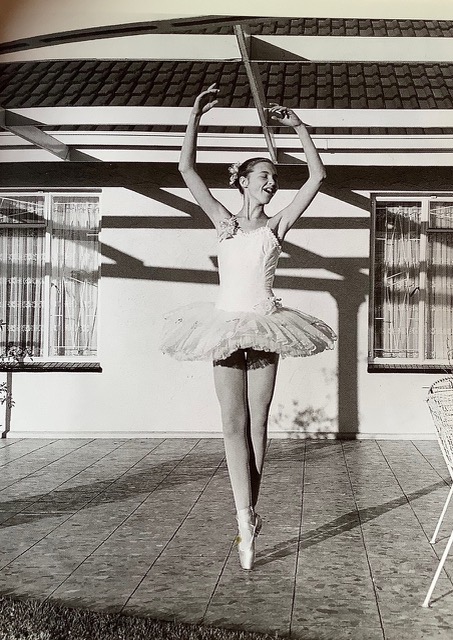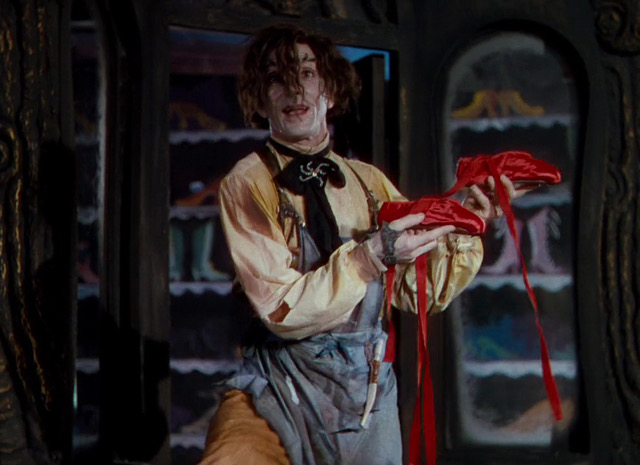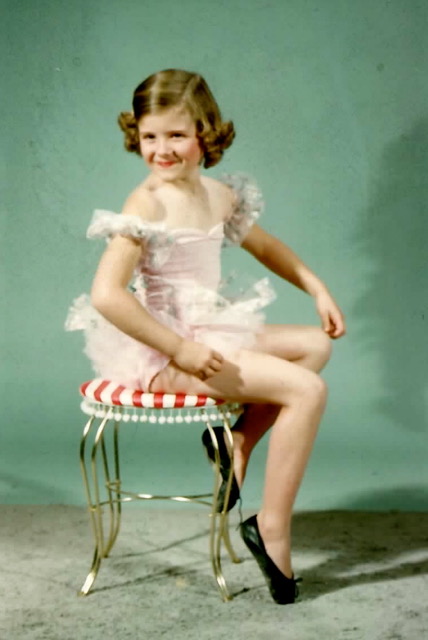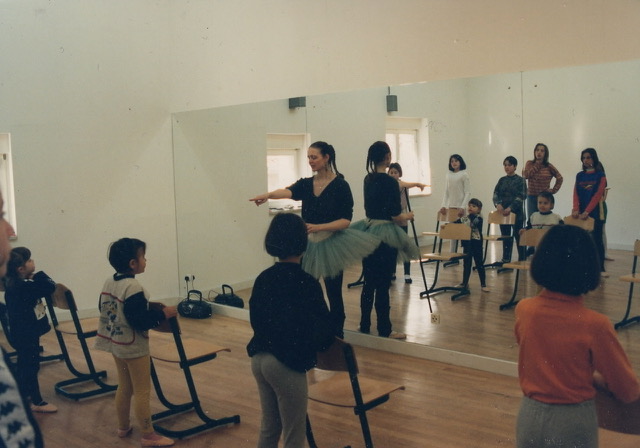
In my old bedroom is a trunk my mother labeled KATIE’S PRECIOUS THINGS. Inside this box of relics is a photograph of me at thirteen. I’m on the back porch wearing the costume my father ordered from New York because no store within a thousand miles of my small desert town had anything like this tutu with sequinned fruit stitched to the strap.
The photo is drenched in sunlight, my eyes closed against the glare. There is a tiara in my hair and a look of rapture on my face. On my feet, a pair of new Capezio pointe shoes. I am balancing on the tips of my toes, legs snapped together like scissors.
In the fading Polaroid my mouth is open, my barbed-wire teeth just visible. My arms are flung over my head. My skinny legs echo the shadows of the naked grape arbor whose beams crisscross themselves in rhomboids behind me. In contrast to the stolid, potato-white house which is my backdrop, I’m wearing a cloud of damson net.
When this picture was taken, ballet was all I lived for. When I was alone at home, I would put on my mother’s heels, elbow-length gloves and faux fur coat. No one knew I swanned around the house pretending to be Anna Pavlova. If I had admitted this to anyone, they would only have laughed. I lived in a border town, not so many years away from Apache massacres, Billy the Kid and the law of the gun.
My mother drove me to my twice-weekly lessons, but never approved of the stage as a career. “Ballet is nice for little girls,” she’d say, “otherwise it’s as useless as a tit on a boar hog.”
✠ ✠ ✠
In my second novel, The Double Happiness Company, I wrote about Katie Rivers, my alter ego who, like me, grew up in the desert where there was little culture to be had. The picture I described is not me, but an unidentified young dancer on her veranda. But it could be me, like so many millions of stage-struck girls around the world who long to wear pink satin pointe shoes the colour of sugar mice and harbour the dream of one day becoming a ballerina.
My father was brought up as a Primitive Baptist in the Deep South in a sect that believed dancing was just short of vertical fornication. Growing up, he was never allowed to dance, but when he moved to New Mexico with my mother in the 1950s, they took up Western square dancing. My parents joined the Do-Si-Do Club that met every Friday evening in the Temple of Agriculture. On those nights they would dress up: my father in his Western shirt, nose-picker boots and bolas tie, my mother in her turquoise squaw dress, the skirt swollen with petticoats and decorated with yards of rickrack. My father didn’t trust babysitters with his four-year-old daughter so I was taken along, wearing my own miniature matching squaw dress. I loved the live band and caller, the forest of trouser legs and nylon stocking spinning above my head. I tried to copy my parents as they allemanded left and right and sashayed back to twirl each other around. Those nights at the Do-Si-Do Club were my first dancing lessons. My first memories of happiness.
At the time, I was too young to know that my parents were hopelessly mismatched, trapped in a marriage that wasn’t fulfilling for either of them. But I saw that when they were dancing, their faces shone. When I danced for them in our living room, leaping and spinning to any music I heard—the radio, my red-vinyl record of Peter and the Wolf or their LPs of “The Sheikh of Araby” or Benny Goodman—it was a surefire way to make them smile.
Some psychotherapists have put forward the view that children with a propensity to dance do so in an attempt to alleviate their parents’ depression, that a child’s urge to dance is “an innocent, inarticulate desire to make things all right.” I don’t know if that was true in my case, but whenever I performed for my parents, they lit up.

When I was five, they took me to see The Red Shoes. I was mesmerised by the Technicolor fairy tale brought to life on the big screen. I have never forgotten Léonide Massine as the scraggly-haired cobbler who fashioned a pair of shoes that made Moira Shearer dance to her death. After seeing the film, I begged to take ballet lessons from the only dance teacher in town. For years, on Tuesdays and Thursdays, I took tap and ballet classes at the Marion McGuire School of the Dance, lessons that increased to six times a week as I grew more determined to make ballet my career. I lived only for those days after school, and the exhilarating promise of the annual May recital.
Dance became my refuge in a town where I felt I didn’t belong, a town of narrow streets and narrow minds. I was considered a kook by my mother because I nursed dreams contrary to the life she had mapped out for me: college, marriage, motherhood. That was the life she had chosen, one I did not want to repeat. As I entered my teenage years, I was considered an oddball among my peers because I had no ambition to be a cheerleader or play a clarinet in the marching band. I didn’t care what anyone thought of me. My enchantment came from far away: Imperial Russia, a glittering world of drama and intrigue.

Again and again, I devoured the few books in the ballet section of the Thomas Branigan Memorial library. I memorised the names and life stories of the great ballerinas and premiers danseurs of the Russian Ballet. I was glad my strait-laced mother had no idea what was in those innocuous-looking books. They included a biography of Vaslav Nijinsky, written by his wife, describing in detail his love affair with Serge Diaghilev, the impresario of the Ballets Russes. I knew by heart the spellbinding story of prima ballerina, Matilde Kschessinskaya, a lover of Tsarevich Nicholas—later Nicholas II. When she became pregnant with his child, the Russian court forbade him to marry a lowly ballerina. The pregnancy was so scandalous a chauffeur was ordered to deliberately crash her car into a snow bank, causing Kschessinskaya to miscarry.
It was in a biography of Anna Pavlova that I read about a bloody incident in St Petersburg that foreshadowed the Russian Revolution. Dancers from the Imperial Ballet were among those in a crowd who had come to the Winter Palace in 1905 to petition the Tsar about increasing their state pensions. The dancers witnessed Cossacks on horseback, charging at peaceful protestors and lashing them with bullet-tipped whips.
Through books, I learned of a riot at the 1913 premiere of The Rite of Spring. Fights broke out in the audience between bohemians who championed the avant-garde and bejewelled aristocrats who hated Stravinsky’s dissonant music and Nijinsky’s foot-stomping choreography. The uproar was so loud in the Théâtre des Champs-Elysées that the dancers couldn’t hear the orchestra. The composer and choreographer had to scream out the counts from the wings so the dancers could continue the performance.
It was through books I escaped my tumbleweed town to walk the streets of St Petersburg and tour the world with Anna Pavlova. As I reached adulthood, some aspects of my life became a reflection of the ballet world I had so often read about. In 1998, I was teaching ballet classes at the Pavarotti Music Centre in post-war Bosnia-Herzegovina. In this shattered city of Mostar, classes were oversubscribed with little girls sorely in need of beauty. We made do with the backs of chairs as barres until I could travel to Sarajevo to take measurements for mounting them: one barre for adults, and a lower one for children.

When I was in the capital, I visited the National Theatre of Sarajavo which, luckily, had suffered only minor damage during the war. The director of the ballet company told me that the dancers had decided they would not let snipers and shelling stop them performing. They recognised that their audience—as well as themselves—needed dance to escape the harsh reality of their lives, if only for a few hours. The director told me about some of the problems they encountered during a siege that lasted 1,425 days. The company couldn’t get pointe shoes, so they chose to perform Ravel’s Bolero, the only ballet in the repertoire that was choreographed for barefoot dancers.
The director said it was nearly impossible to get stage make-up. A dancer who needed to buy powdered milk for her child couldn’t squander money on face powder, Panstick and false eyelashes. Because the male dancers in the company were serving as soldiers, no one knew how many would be able to show up for the performance on any given night. One soldier was stationed 20 miles away on Mount Igman. His commander had to give permission for him to walk to the theatre, dance, then hurry back to his unit in the trenches to defend the city.
As I entered the studio to take the barre measurements, I noticed a long wall of mirrors unlike any I had ever seen. The huge expanse was covered in dozens of long rectangles of glass, fixed horizontally. I asked the director about the strange configuration that distorted the dancers’ reflections. She explained that when the nearby Markale Market was shelled in 1994, the blast shattered the mirrors. Because mirrors are essential for dancers to train properly, they applied to the George Soros Foundation to purchase new ones.
The money was donated, but it was a dangerous journey to get the mirrors into the city centre. The large panels had to be carried by hand over Mount Igman and then through the Sarajevo Tunnel. This tunnel had been hand-dug with picks and shovels by the Bosnian Army to allow food, war matériel and humanitarian aid to enter the city. The average height of the tunnel was 1.6 meters—5.25 feet. The director explained that this was why the mirrors were shaped like sticks of chewing gum: they had to be small enough to be carried by men unable to stand upright. People, she said, had risked their lives to bring them here. They had believed the mirrors were worth dying for.
Dance is food for the soul. It saves us in ways that are impossible to quantify. It is an art form that can transport us away from a life we are unhappy with, even away from the horrors of war. As the choreographer Merce Cunningham once said, ‘Dancing gives you nothing but that single fleeting moment when you feel alive.’

What a superb piece. Dance – making art with the body – Anne is also a superb writer. I recommend the Double Happiness Company. I have loved her writing courses; they’ve brought my own stuff on, and I lean in and listen to everything she days about art.
Lovely evocative piece by Anne Aylor – the power of healthy obsession to transcend circumstances and make life vivid with possibilities. I totally get the hold it exerted over her; the way it kept the forces of drabness and conformity at bay.
Not that I know what I’m talking about. When it comes to dancing, I’ve two left feet, possibly three. Or more. They seem to multiply and start quarelling every time I take to the floor. Which these days is mercifully rare for would-be partners or spectators, on account of a dodgy knee. I reckon I’m dance-damaged, and I blame the aptly-named Twist, which was the only dance whose “steps” I could manage. Just like it said in the Daily Mirror’s pull-out guide, all you had to do was rotate your feet on their balls and pretend you were towelling your lower back.
Still the Twist was a life-saver with its no-steps format at a time of compulsory foxtrotting and quickstepping. To make it worse, my father was a….ballet critic, for heaven’s sake and my mother had been a gifted dance student as a girl growing up in Brazil. They’d met during the war when he was a paratrooper convalescing in the Canterbury hospital where she was a V.A.D. (Voluntary Aid Detachment) nurse. As far as I could gather, the postwar dance halls like Hammersmith Palais figured strongly in their courtship. Several decades later I went and married a former ballroom champion.
My Dad became editor of The Dancing Times and wrote a bestseller called The Girl’s Book of Ballet. For a while he was a cricket coach at the White Lodge Ballet School in Richmond Park. He knew your Margot Fonteyns and Anton Dolins, and wrote loads about the great Russian dancers, not least Nureyev and his defection to the west. All this came back to me as I read Anne’s piece – the exotic figures in their lives of dance – the rigours to which they subjected their bodies. Flying humans; grounded gods.
Many years later, when I was writing for The Times, my colleagues reckoned that because of my “background” I would know something about ballet. I didn’t. But I did get to meet and write about the extraordinary Carlos Acosta; his indebtedness to the training options opened up in his native Cuba during the Castro years. And Darcey Bussell, healing herself with Pilates after a difficult childbirth. I felt a bit of a fraud while talking to such people, but if they suspected, they didn’t let on.
Well done, Anne, for evoking dance so well, in all its challenges and rewards. Having read her blog, I find myself wondering if writing and dancing have more in common than is generally reckoned. Maybe something to do with putting wayward impulses into some kind of order. Maybe not.
That was so lovely to read , I can relate to the way dancing transformed her into another world , after WW11 I attended Hamel school of dance twice weekly,bless my Mom for coughing up the money ,beside the tuition fee their was extra costume expenses . Their wasn’t much going for anyone back then but those two nights a week made me feel that I was on a Broadway stage .
Just lovely. Your writing is always beautiful, engaging and informative. I truly enjoyed reding it.